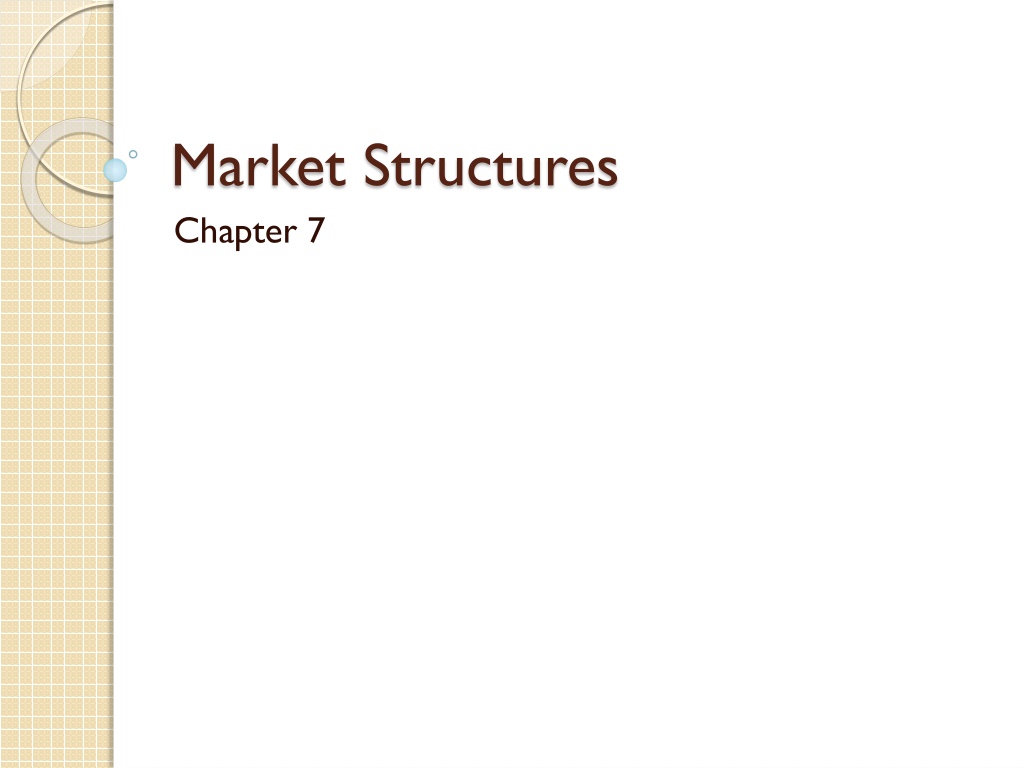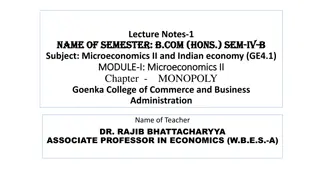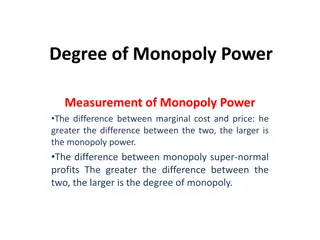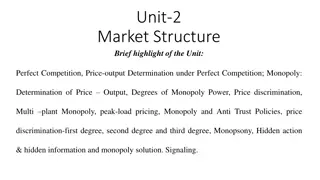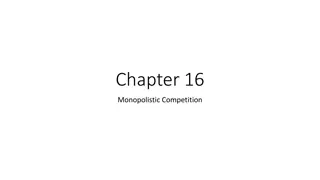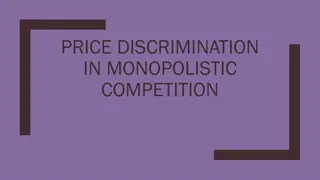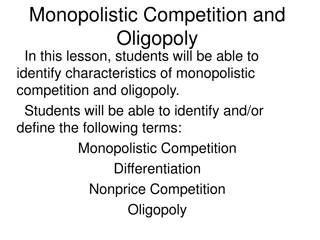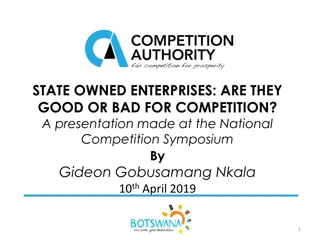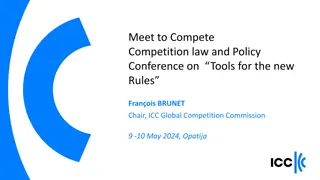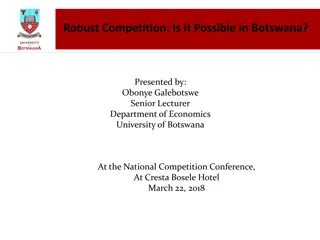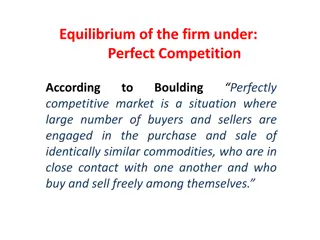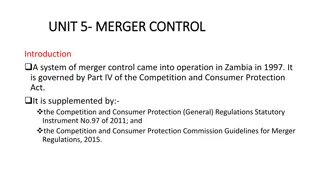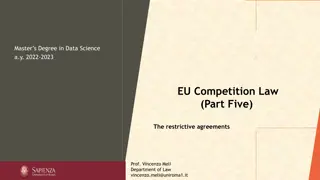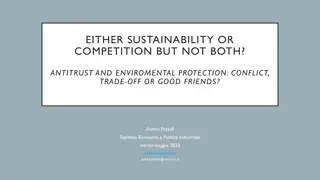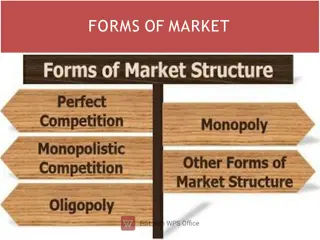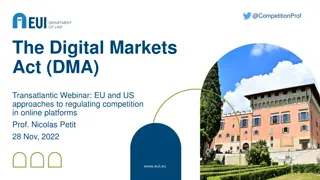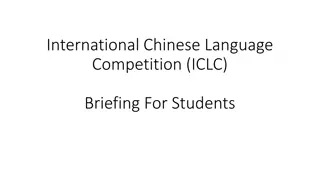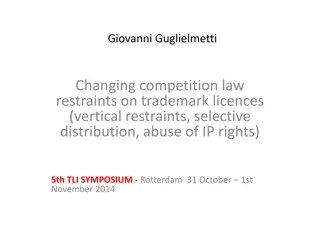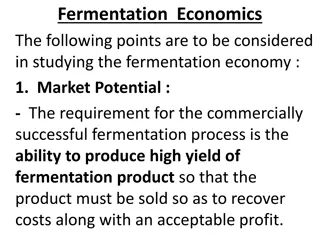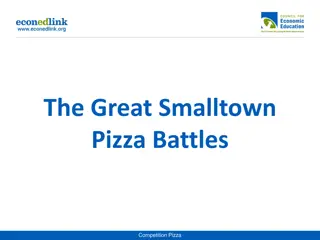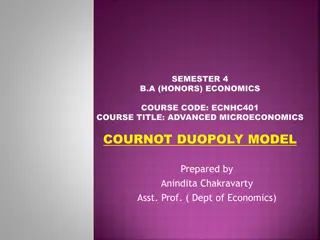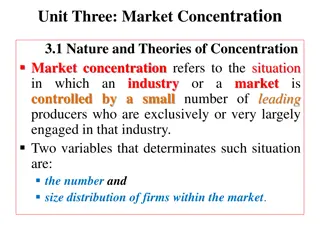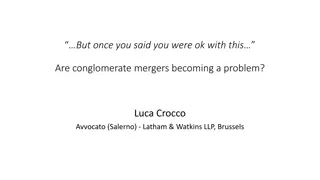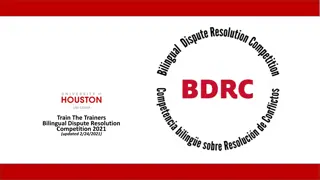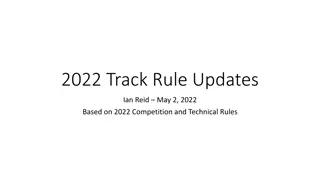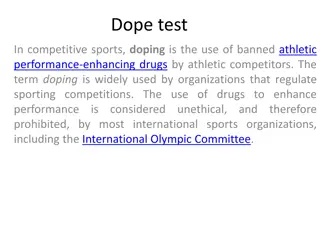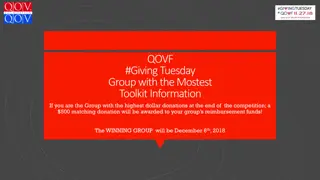Market Structures: Perfect Competition vs Monopoly
Perfect competition features identical products, many sellers, and low barriers to entry, promoting efficiency. Monopolies, with one seller, can abuse power but are allowed in select industries. Understanding market structures is crucial for economic analysis and policy-making.
Download Presentation

Please find below an Image/Link to download the presentation.
The content on the website is provided AS IS for your information and personal use only. It may not be sold, licensed, or shared on other websites without obtaining consent from the author. Download presentation by click this link. If you encounter any issues during the download, it is possible that the publisher has removed the file from their server.
E N D
Presentation Transcript
Market Structures Chapter 7
Section One PERFECT COMPETITION
The simplest market structure to study is one known as perfect competition. In perfect competition, every firm produces the identical product for the same price. In perfect competition, each firm produces a small part of the total supply so no one firm can control the price. Instead, all they can decide is how much they can produce, based on production costs and market price.
Four conditions for perfect competition: 1. many buyers and sellers 2. sellers offer identical products 3. buyers are well informed 4. sellers can enter and exit the market easily.
Only a few industries come close to meeting these conditions. Two examples of perfect competition are farm products and the stocks traded on a stock exchange. Factors that make it difficult for new firms to enter a market are called barriers to entry. Common barriers to entry include start-up costs and technology. Start-up costs are the expenses an owner has to pay before opening a new business.
For example, before starting a new sandwich shop you would have to rent a store, buy cooking equipment, and print menus. Other businesses require technical ability. Carpenters, pharmacists, or electricians need training before they can have the skills they need. Perfectly competitive markets are efficient due to intense competition. Prices and costs are kept as low as possible. A firm that raised its prices higher than other firms, or experienced higher production costs, would not be able to compete.
Section Two MONOPOLY
A monopoly is a market dominated by a single seller. Instead of many buyers and sellers, as is the case with perfect competition, a monopoly has one seller and any number of buyers. Barriers to entry make monopolies possible. Monopolies can take advantage of their monopoly power and charge high prices. For this reason, the United States has outlawed monopolistic practices in most industries.
The government allows monopolies in certain industries. A natural monopoly is a market that runs most efficiently when one large firm provides all the output. In the local telephone industry, a monopoly developed because it was inefficient for more than one company to build an expensive wire network. Other examples of natural monopolies could include city water, electric providers, and natural gas. In such cases, the government may give one company the right to dominate a geographic area. In return, that company will agree to let the government control its prices.
The government can also grant monopoly power by issuing patents or licenses. A patent gives a company exclusive rights to sell a new good or service for a specific time period. A license is a government-issued right to operate a business. Radio licenses give a station the right to broadcast at a certain frequency.
Unlike firms in perfectly competitive markets, monopolists have control over prices. However, the law of demand means that when the monopolist raises the price, it will sell fewer goods. The monopolist sets a price that maximizes its profit. This usually means fewer goods and higher prices than a competitive market.
Section Three MONOPOLISTIC COMPETITION AND OLIGOPOLY
Perfect competition and monopoly are the two extremes in the range of market structures. Most markets fall into two other categories: monopolistic competition and oligopoly. Monopolistic competition is a market in which many companies sell products that are similar but not identical. For example, jeans can differ in brand, style, and color. Ice cream differs in taste and flavors. In monopolistic competition, each firm has a monopoly over its own particular product. For example, Apple has a monopoly of sorts on iPhones. Monopolistic competition exists in industries where there are low barriers to entry.
Firms that are monopolistically competitive have slight control over their prices. This is because they offer products that are slightly different from any other company s. They also use non-price competition, or competition through ways other than lower prices, to compete. They may offer new colors, textures, or tastes in their products. They may also try to find the best location for their services.
Oligopoly is a market dominated by a few large firms. It can form when significant barriers to entry exist. Examples of oligopolies in the United States include air travel, cola, breakfast cereals and household appliances. Oligopolistic firms sometimes use illegal practices to set prices or to reduce competition. They may engage in price fixing, an agreement among firms to sell at the same or very similar prices. Price fixing is illegal in the United States and can lead to heavy penalties.
Which of these products are NOT made by Coca-Cola?
Section Four REGULATION AND DEREGULATION
Monopoly and oligopoly can sometimes have negative effects on consumers and our whole economy. Markets dominated by only a few large firms tend to have higher prices and lower output than markets with many sellers. A firm with monopoly power can use predatory pricing. Predatory pricing is the practice of setting the market price below cost to drive competitors out of business. Another way firms try to reduce competition is by buying out their competitors.
Since the late 1800s, the United States has had antitrust laws to prevent companies from reducing competition. It is the job of the Federal Trade Commission and the Department of Justice s Antitrust Division to enforce antitrust laws. The government also tries to prevent mergers that might reduce competition and lead to higher prices. A merger is when two or more companies join to form a single firm.
In the 1970s and 1980s, Congress passed laws leading to the deregulation of some industries. Deregulation is the lifting or reducing of government controls over a market. Markets experiencing deregulation included the airline, electricity, banking, railroad, natural gas and television broadcasting industries. When it is successful, deregulation increases competition and leads to lower prices for consumers. However, it may often cause hardship for employees of companies driven out of business by increased competition. Antitrust laws strengthen government control over a market. Deregulation loosens government control. Yet both policies have the same purpose: to promote competition.
TYPES OF GOODS CONTROL OVER PRICE EXAMPLES TYPE OF MARKET BARRIERS TO ENTRY AMOUNT OF FIRMS PERFECT COMPETITION MONOPOLY MONOPOLISTIC COMPETITION OLIGOPOLY
